Functional Magnetic Materials: Synergy Between Basic Science and Evolving Technology
S. B. Roy
1Materials and Advanced Accelerator Sciences Division, 2Raja Ramanna Centre for Advanced Technology Indore-452013, India
Introduction
The application of magnetism and magnetic materials pervades our modern civilization in the form of electrical power, communications and information storage. The intensity and importance of such applications are reflected in the multi-billion dollar per year market for magnetic materials in three broad areas: hard magnets, soft magnets, and magnetic recording.1 Continuous evolution in the field of magnetic materials has not, however, remained confined to these well-identified areas. Often classes of magnetic materials are discovered with interesting functionality, which stimulate the growth of new technology. In this article we discuss some such magnetic materials, where a solid-to-solid thermodynamic phase transition gives rise to interesting functional properties with futuristic applications.
Magnetic Materials with Phase Transition-driven Functionality
During the last two decades, three classes of magnetic materials have emerged with much promise for immediate technological applications. These are: 1) giant magneto-resistance materials; 2) magneto-strictive materials, including magnetic shape memory alloys; and 3) magnetocaloric materials.
The change in electrical resistance in a material with an applied magnetic field—commonly known as 'magneto-resistance'—finds applications in sensors in several areas of technology. For example, small personal computers now come outfitted with high capacity hard drives which use giant magneto-resistance (GMR) sensors as a read head. The basic GMR device consists of a three-layer sandwich of a magnetic metal such as cobalt or iron with a nonmagnetic metal filling such as silver or platinum.2 The discovery of interesting GMR properties came as a bonus out of curiosity-driven scientific research to shed light on the fundamental question of magnetic interactions in materials; and from the first report in the mid-1980s it took less than ten years for the first product to arrive in the form of "read heads" for computer hard disk drives. This discovery naturally spurred more research activities, and in early 1990s a class of rare-earth manganese oxide materials (commonly termed as manganites) were identified with colossal magneto-resistance (CMR) properties.3 Manganites show exotic physical properties in the form of a metal-insulator transition and a variety of magnetic, charge, and orbital ordering forms dictated by strong electron-electron interactions and electron-lattice interactions, provide a challenging area of research.
Shape memory alloys (SMA) are metals that can revert to a predetermined shape after any mechanical deformation.4 The shapememory effect is caused by a thermoelastic martensitic transition between two different crystal microstructures. SMAs started drawing much attention from the early 1960s with the discovery of shapememory effect in nickel-titanium alloys,4 and over time a number of commercial products came to the market. The conventional SMAs; however, have one drawback-they are relatively slow to respond to variations in temperature and the flow of heat. A class of materials known as magnetic shape-memory alloys (MSMA), discovered in the mid-1990s, can undergo large reversible deformations in an applied magnetic field.5 The magnetic field control enables a relatively fast response in the MSMAs in comparison to the usual SMAs.
The magnetic field-induced isothermal entropy change or adiabatic temperature change in a magnetic solid is known as 'magneto-caloric effect' (MCE). Originally observed in iron in 1881, MCE offers the prospect of magnetic cooling technology, which has a potential to reduce global energy consumption and avoid the need of ozone depleting and greenhouse gas chemicals. In an MCE material, randomly oriented magnetic moments are aligned by an applied magnetic field in a magnetic-refrigeration cycle, resulting in reduction of magnetic entropy. In turn, the MCE material is heated via the increase of its lattice entropy. This heat is then removed from the material to its surroundings by a heat-transfer medium. On removing the magnetic field, the magnetic moments become randomized causing an increase in the magnetic entropy. This, in turn, leads to cooling of the MCE material below the ambient temperature. The prospect of magnetic cooling as a possible alternative to vapor-compression technology has increased enormously since the discovery of giant MCE in various classes of magnetic materials during last two decades.6,7
This article discusses certain common experimental features, which lead to interesting functional properties in these distinct types of magnetic materials–magneto-resistance materials, MSMAs, and giant MCE materials. A disorder-influenced first order phase transition provides the key to understanding and tuning the observed functional properties. Often all three functional properties are observed in the same material. This generality will be highlighted with the case study of a NiMnIn-based shape-memory alloy, which shows a large magneto-caloric effect, large magneto-resistance and large magneto-striction driven by a first order magneto-structural phase transition. A brief comparison is made with other classes of magnetic materials including giant magneto-caloric materials and CMR-manganites.
Phenomenology of First Order Phase Transition (FOPT)
FOPT is omnipresent in nature, with the classic example being boiling and freezing of water. The existence of FOPT involving a change in the lattice and/or spin degree of freedom in solid materials is also fairly well known. However, it is only during the last decade or so it has become apparent that the change in the magnetic and lattice structure associated with such FOPT in a material can actually give rise to interesting functional properties of technological importance.
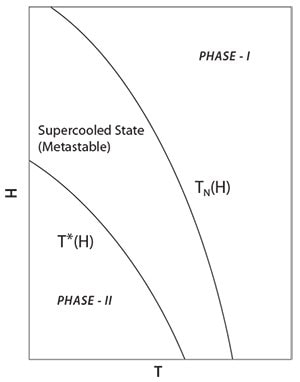
Figure 1.Schematic (H,T) phase diagram showing the phase transition line TN(H) and the stability limit T*(H) for the supercooled state.
In a magnetic solid, an FOPT is identified across a TN(H) (here TN is the phase transition temperature) line in the two-parameter magnetic field (H)-temperature (T) phase space (Figure 1), by a discontinuous change in entropy (i.e., measureable latent heat) or a discontinuous change in magnetization (M) as this TN(H) line is crossed by varying either of the control variables T or H. The high- and low-temperature phases coexist at the transition temperature T=TN, and the high temperature phase continues to exist as a supercooled metastable state until the temperature T*.8 The limit of metastability (superheating) while heating is reached at T**(H)>TN(H), and this is not shown in the schematic (H,T) phase diagram (Figure 1) for the sake of clarity. In a similar way the limits of metastability H* and H** can be defined across an isothermal magnetic field-induced FOPT.
The functional magnetic materials of present interest are mostly multicomponent alloys and chemical compounds, where the actual composition varies around some average composition due to disorder that is frozen in as the solid crystallizes from the melt. In a pioneering work, Imry and Wortis9 showed that such static, quenched-in, purely statistical compositional disorder would introduce a landscape of transition temperatures in a system undergoing FOPT. In addition, disorder will also cause a phase-coexistence of equilibrium and metastable phases associated with supercooling/superheating in the H-T region encompassed by TN−T*(T**) lines. Such phase coexistence gives rise to hysteretic behavior in an observable property across an FOPT. While thermodynamic properties are the most commonly measured other physical properties can also display hysteretic behavior.10
Ni50Mn34In16 Heusler Alloy: A Representative Multifunctional Material
Ni50Mn34In16 belongs to the same family of Heusler alloys as that of the well-known magnetic shape-memory alloy Ni2MnGa, which undergo a martensitic transition (an FOPT) from high-temperature austenite phase to low-temperature martensite phase. These Heusler alloys have an L21 cubic crystal structure in the austenite state, with different types of structure possible in the martensite state, the most prevalent one being the tetragonal L10 structure.
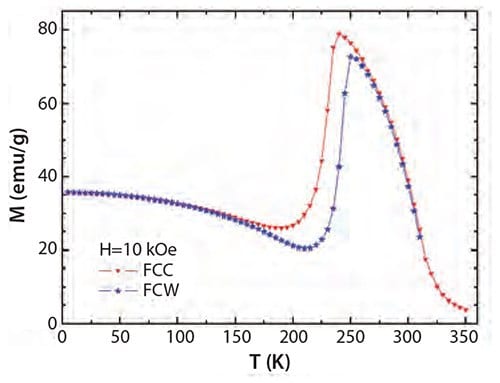
Figure 2.Magnetization (M) versus temperature (T) plot for Ni50Mn34In16 alloy obtained while cooling in a magnetic field of 10 kOe (FCC mode) and warming in the same field (FCW mode).11
Figure 2 presents a magnetization (M) versus temperature (T) plot for the Ni50Mn34In16 alloy, which exemplifies the large change in magnetization across the martensitic transition taking place around 240 K.11 A distinct thermal hysteresis is observed in the phase transition temperature region, which highlights the first order nature of this transition.11 A magnetic field-induced transition from a low magnetization martensite state to a higher magnetization austenite state is observed in the low temperature region in many off-stoichiometric compositions of Ni2MnIn Heusler alloys, including the present Ni50Mn34In16 alloy. The typical isothermal M-H curves showing magnetic field-induced martensite to austenite phase transition are presented in Figure 3. The various characteristic features of such M-H curves can be explained within the framework of a disorder-broadened FOPT.11
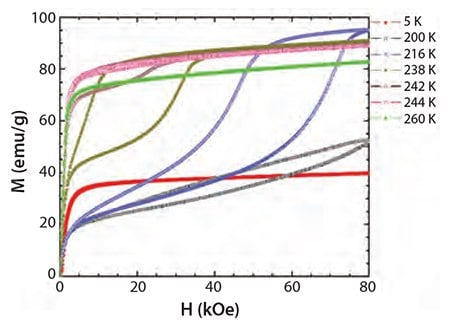
Figure 3.Isothermal magnetization (M) versus field (H) curves of Ni50Mn34In16 alloy at representative temperatures.15 The M-H curves at T=200 K, 216 K, 238 K, 242 K, and 244 K show the signature of a field-induced transition from martensite to austenite phase.11
Scanning Hall-probe imaging experiments have been performed across the magnetic field-induced martensite to austenite phase transition in the Ni50Mn34In16 alloy; these provide snapshots of the coexistence of the martensite phase (with a low value of magnetization) and the austenite phase (with a high value of magnetization) on a length scale of tens of micrometers, extended over a wide magnetic field regime.12 Furthermore, the characteristics exhibited by the local Hall voltage loops indicated the presence of a landscape of critical magnetic fields for the martensitic phase transition across the sample confirming this magnetic field-induced FOPT in the Ni50Mn34In16 alloy is influenced by disorder. This kind of disorder-induced landscape of transition temperatures or magnetic fields9 along with phase-coexistence and metastability had previously been observed in doped-CeFe2 alloys (which belong to the same family as that of the well-known commercial magneto-strictive material Terfenol-(Tb,Dy)Fe2) with multifunctional properties.13
The observed large drop in magnetization across the FOPT in the Ni50Mn34In16 alloy (Figure 2) and the magnetic field dependence of the transition temperature lead to a large isothermal entropy change of about 18 J/kg-K for a magnetic field variation of 50 kOe.14 Similar large magneto-caloric effects (MCE) associated with the FOPT have been observed in other compositions of Ni-Mn-In Huesler alloys.15 Magnetic and structural inhomogeneities in the phase-coexistence regime are at the root of the observed large MCE. It is now recognized that latticeentropy change accounts for about one half of the total entropy change in such NiMnIn alloys; and this, in turn, points to the important role of magneto-structural coupling.16 The same temperature- and magneticfield induced FOPT also gave rise to GMR17 and superelasticity18 in the Ni50Mn34In16 alloy. The martensitic transition temperature of Ni50Mn34In16, along with the functional properties, can be shifted towards room temperature with Cr-doping at Mn sites and Cu-doping at the Ni sites.19 Figures 4-6 present examples of multifunctional properties in a 1% Cu-doped Ni50Mn34In16 near room temperature.
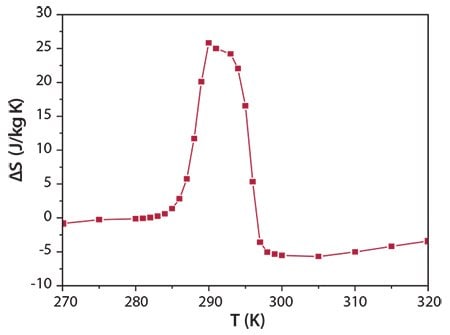
Figure 4.MCE (represented by isothermal entropy change) versus temperature plot in 1% Cu-doped Ni50Mn34In16 alloy for a magnetic field variation of 45 kOe.19
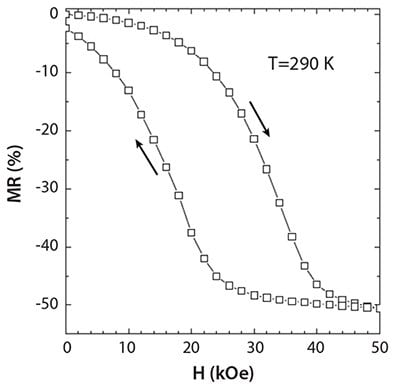
Figure 5.Isothermal magneto-resistance as a function of magnetic field in 1% Cu-doped Ni50Mn34In16 alloy at T=290 K.19
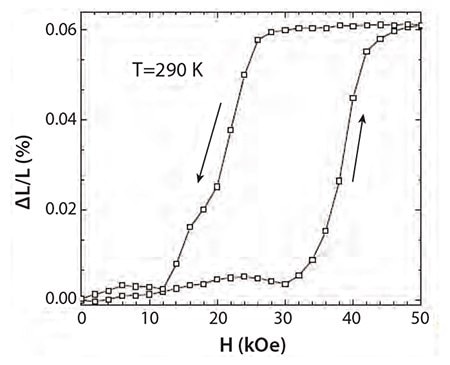
Figure 6.Isothermal strain as a function of magnetic field in 1% Cu-doped Ni50Mn34In16 alloy at T=290 K.19
Commonality with other Multifunctional Materials
The thermomagnetic hysteresis, phase-coexistence, and metastability discussed above for Ni50Mn34In16 are the characteristic features of a disorder-influenced FOPT and have been observed in various other classes of functional magnetic materials. We present below a brief discussion on the giant MCE material Gd5Ge4, CMR-manganites and equi-atomic FeRh alloys to highlight the role of disorder-influenced FOPT in the multifunctional properties of these materials. The generality of this observation can be extended to many other materials, including LaFe13-xSix and MnCoGeBx, but a detailed discussion is beyond the scope of this article.
The parent compound Gd5Ge4 undergoes a low temperature first order antiferromagnetic (AFM)-to-ferromagnetic (FM) transition in the presence of an applied magnetic field. Thermomagnetic hysteresis is one of the numerous evidences pointing toward the first order nature of this AFM-FM phase transition in Gd5Ge4.10 Scanning micro-Hall probe technique has been used to image the AFM-FM transition in Gd5Ge4, and revealed the coexistence of FM and AFM phase in micrometer scale in a finite H-T regime around the first order phase transition line showing the validity of a TN/HM landscape picture in Gd5Ge4.10 In combination with dimensional analysis and numerical simulation, these results further pointed out how this AFM-FM phase-coexistence and the associated dynamics (nucleation and growth) could provide useful information for tuning the functional properties of Gd5Ge4.
The unique layered structure of Gd5Ge4 is at the root of the observed temperature and magnetic field-induced first order structural transition from a monoclinic-paramagnetic to an orthorhombic-ferromagnetic structure in these alloys, which in turn gives rise to giant MCE.20 The first order AFM-FM transition in Gd5Ge4 is also accompanied by magnetoelastic effect, which gives rise to large magneto-striction21 and magneto-resistance.22
A first order phase transition from a metallic FM state to an insulating charge-ordered AFM state in La0.5Ca0.5MnO3, marked by sharp drop in M (T) and change in the resistivity (ρ) by several orders of magnitude, was reported in one of the earliest works on CMR-manganites.23 A distinct thermal hysteresis was observed in both M(T) and ρ(T) in the phase transition region, and this was taken as a signature of the FOPT.24 A drastic change of lattice constants was also observed in the vicinity of the AFM-FM transition in La0.5Ca0.5MnO3.24 Kuwahara et al. reported a similar first-order FM-AFM transition in Nd0.5Sr0.5MnO3.25 An AFM-FM transformation could be induced inside the AFM state with the application of an external magnetic field, and was clearly marked with sharp changes in physical properties and the accompanying hysteresis.25 A percolation path involving the metallic FM phase in the phasecoexistence regime across the AFM-FM transition, which could be manipulated by an applied H, was proposed as a promising framework to explain the colossal magneto-resistance observed in the manganites.3 Subsequently, the existence of this percolative conducting path in the phase transition region has been confirmed experimentally,26 and a distinct phase-coexistence on a micrometer scale has been observed.27,28 A substantial magneto-caloric effect (MCE) associated with the first order AFM-FM transition has been reported in several CMR-manganites.6,29 The magnetic field-induced change in the configurational entropy associated with the structural transition and the magnetic inhomogeneity arising from the AFM-FM phase-coexistence across the disorder-influenced AFM-FM FOPT, are responsible for the large observed MCE. The commonality in the various features associated with the H- and T-induced first order AFM-FM transition in CMR manganites systems, giant magneto-caloric materials Gd(Ge,Si)4, and doped -CeFe2 alloys has been previously highlighted.10
Another system of interest is the equi-atomic FeRh alloy, which forms in the cubic CsCl-type structure and undergoes a first order phase transition from an FM to an AFM state around 330 K. This FOPT in the FeRh alloy gives rise to GMR, giant MCE, giant elastocaloric effect and giant magneto-striction close to room temperature. Thermomagnetic history effects, phase coexistence and the landscape of transition temperatures associated with the FOPT in Fe-Rh alloy have been studied in detail through magnetization, magnetic force microscopy, and linear strain measurements.30-32 It has been shown that an MCE of about 12 J/kg-K reproducible under multiple field cycles could be achieved in FeRh-based alloys by properly choosing a combination of isothermal and adiabatic field variation cycles in the H-T phase space.31
Table 1 presents a comparison of first order phase transition-driven magneto-caloric effects in various classes of magnetic materials discussed above. The temperature T where isothermal entropy change attains its maximum value | ΔSmax |, usually coincides with the first order phase transition temperature of the material concerned.
Interdisciplinary Research Gains
The interesting features associated with an FOPT play important roles in a wide variety of real-life phenomena like the formation of rain clouds, the supercooling of fish blood, the survival of trees in the arctic region, and the formation of metallic alloys.33 Scientific research on functional magnetic materials can also help in the deeper understanding of such FOPT processes in general. Such materials can actually be used as test bed materials to study an FOPT process in a two-parameter H-T phase space. Knowledge gathered in exploring the H-T phase space in magnetic materials can be applied in other areas of technological interest, including vortex matter phases of type-II superconductors and ferroelectric materials. While implications in ferroelectric materials are well known, the understanding of vortex matter phase space will be useful for tuning the dissipationless current-carrying capacity of a type-II superconductor.
Some liquids called "glass formers" experience a viscous retardation of nucleation and crystallization in their supercooled state and, instead of undergoing a liquid-solid phase transition, they enter into a glassy state. The nature of this glass transition is considered to be one of the important unsolved problems in condensed matter physics.34 It has been observed that in certain regions of the H-T phase diagrams of the different functional magnetic materials (CeFe2-based alloys, Gd5Ge4, CMR-manganites, NiMnIn Heusler alloys and RhFe discussed in sections above) there is a viscous retardation of nucleation and growth of the low-temperature phase across the FOPT.10 The low-temperature state attains a configuration consisting of a fraction of transformed low-T equilibrium phase (e.g., AFM in doped CeFe2 alloys and FeRh, and FM in Gd5Ge4) distributed randomly in an untransformed non-equilibrium matrix of the high-T phase (e.g., FM in doped CeFe2 alloys and FeRh, and AFM in Gd5Ge4), and this configuration is frozen in time. The onset of
this non-trivial low temperature glass-like non-equilibrium state is marked by characteristic dynamic features, which are usually considered to be the hallmark of a structural glass transformation.10 This nonequilibrium state is given the name "magnetic-glass,"35 which is distinctly different from a conventional spin-glass state, where the spin configuration is frozen at random on a much shorter microscopic scale; or from a spin-ice state, where disorder of the magnetic moments at low temperatures is analogous to the proton disorder in water ice.36 Easy accessibility of the experimental H-T phase space of such magnetic materials may provide opportunities for deeper studies of kinetic arrest of an FOPT leading to a glass-like state. In contrast, similar exploration in a more conventional pressure-temperature phase space is relatively difficult. Only very recently has it been discovered that liquid germanium can undergo a glassy transition in the presence of applied pressure.37
Future Outlook
In summary, a first order magneto-structural transition is a common phenomenon observed in many classes of functional magnetic materials of current interest, independent of the nature of their microscopic magnetic interactions. The coupling between spin and lattice degree of freedom is an important ingredient in this temperature and magnetic field-induced transition. Phase-coexistence and metastability are the characteristic features of the transition process and they influence the functionalities observed in the materials. Understanding these phenomena in detail will help tune the multifunctional properties of the existing materials as well as find new materials with improved functionality. The utility of CMR-manganite materials and shape-memory Heusler alloys as potential MCE materials in future magnetic cooling technology has also been recognized. It is clear the stronger the MCE the higher the efficiency of a magnetic refrigerator will be and, in this direction, materials with first order magneto-structural phase transition will play an important role. With the improvements in magnetic materials, magnet systems, and understanding of the active magnetic regenerator cycle, there is promise that mature, environmentally friendly magnetic refrigeration technology will soon produce thermodynamic efficiencies comparable to or higher than the best available gas compression devices.
References
To continue reading please sign in or create an account.
Don't Have An Account?